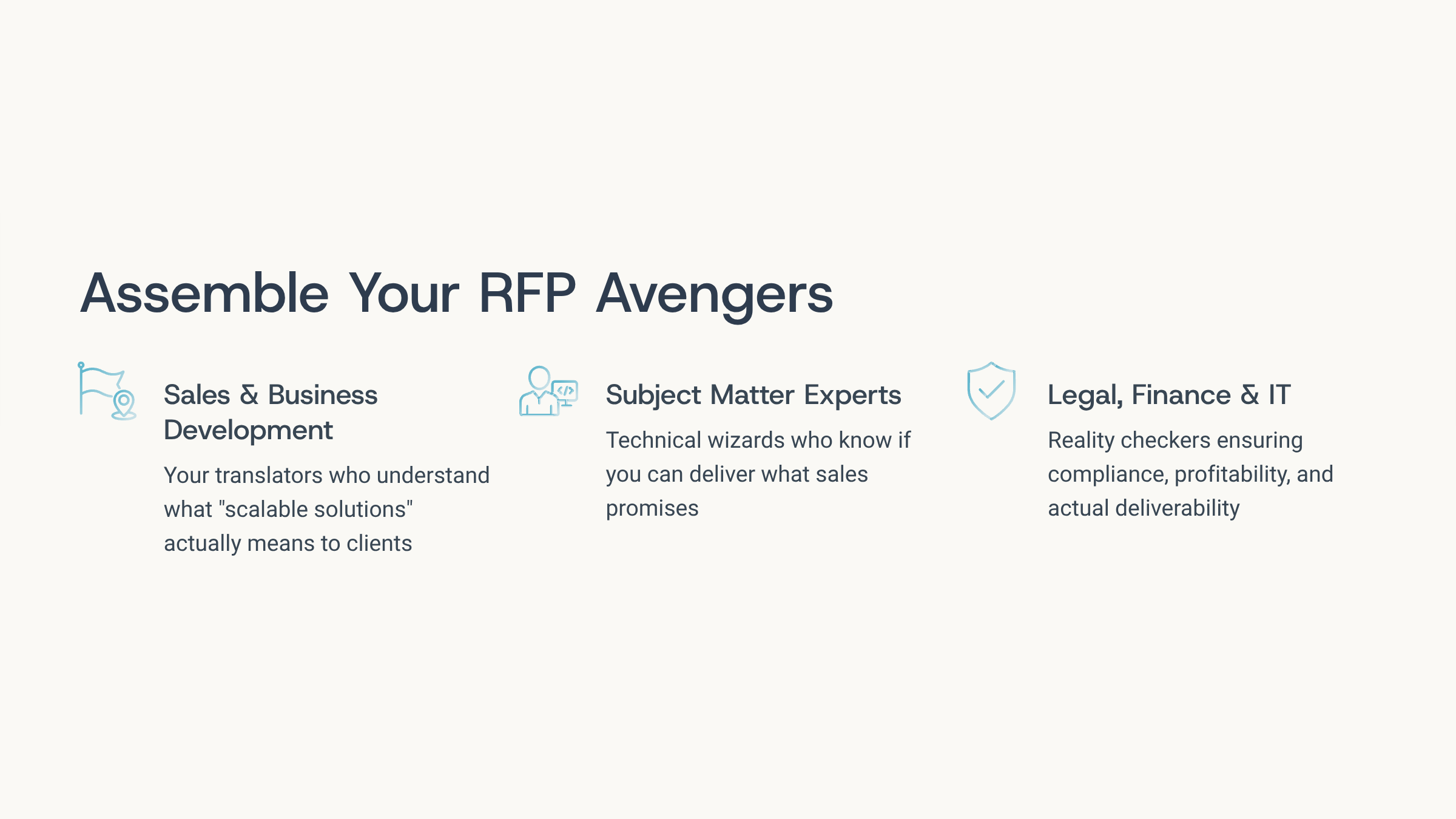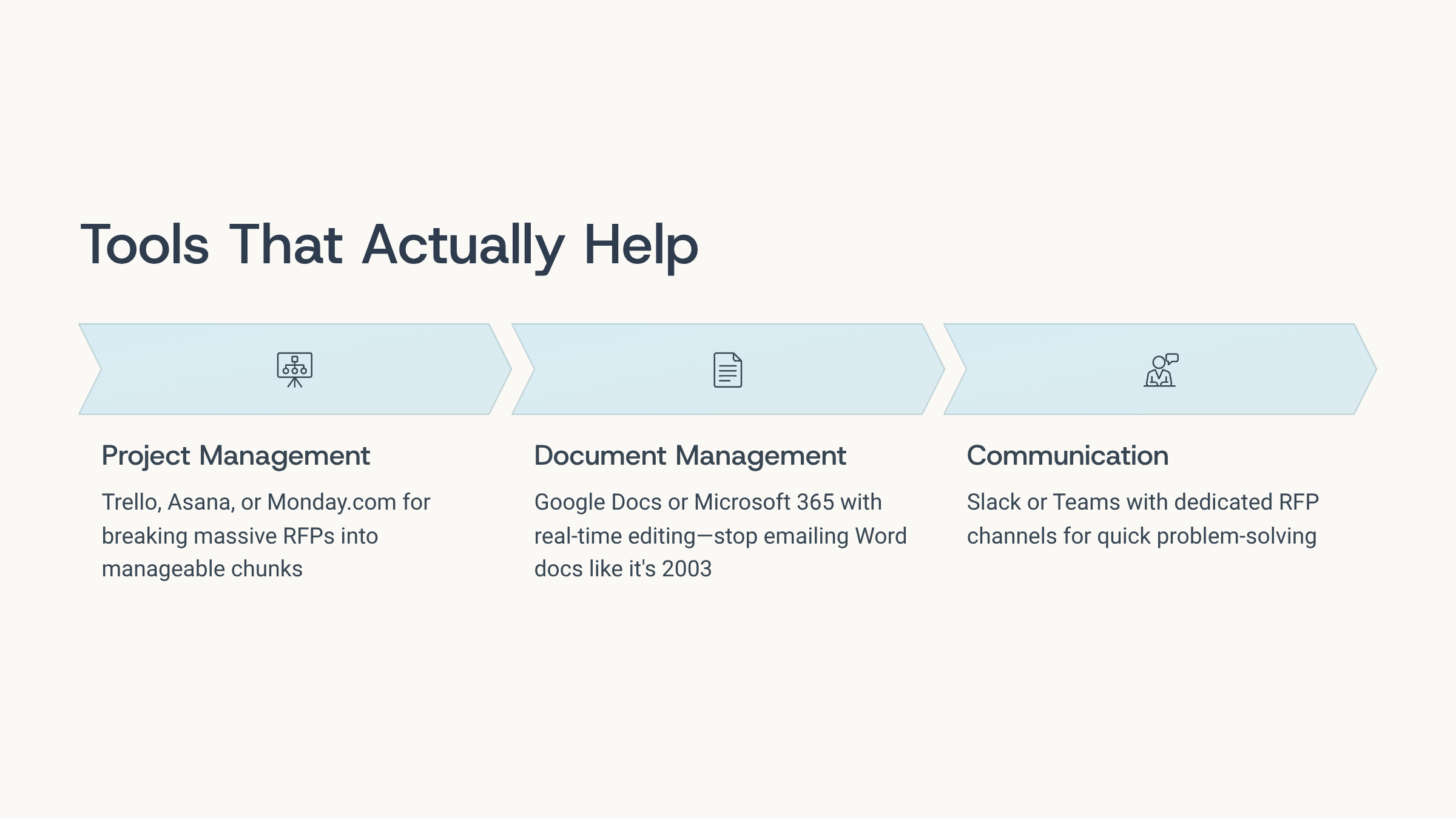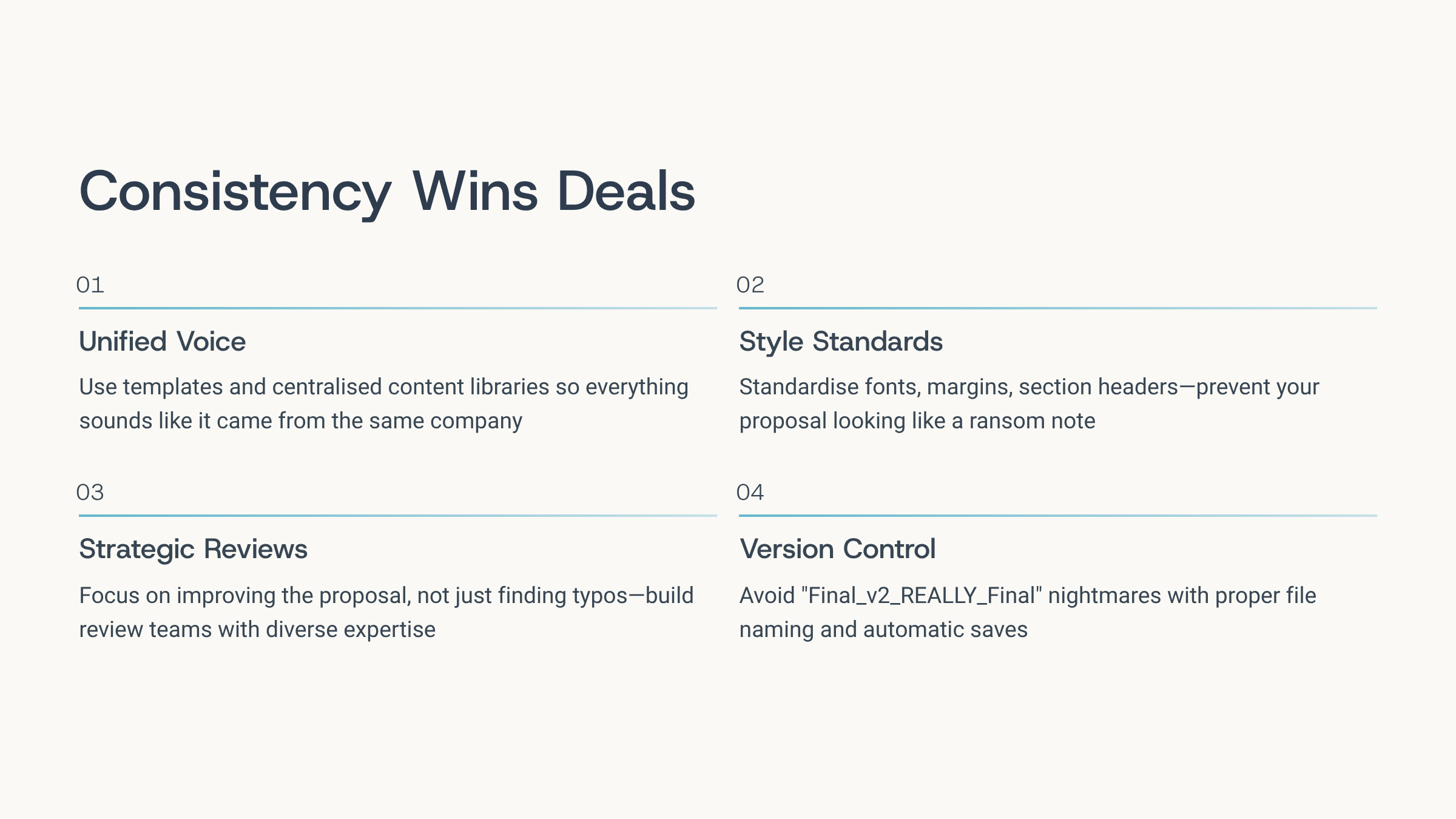Team Collaboration on RFPs: Essential Steps to Build Winning Proposals
Article written by
Kate Williams

INSIDE THE ARTICLE
SHARE THIS ARTICLE
Summary
Manual proposals waste time and lose deals. A smart sales proposal generator speeds up creation, ensures accuracy, and helps every rep send professional, winning proposals in minutes. This blog shows how teams save hours, boost win rates, and turn proposal chaos into a scalable revenue advantage.
Here's what I've learned after watching too many great sales teams struggle with RFPs: the problem isn't usually your solution or your pricing. It's that your internal collaboration process is a roller coaster.
But here's the good news—fixing this is way easier than you think. And when you get it right, everything changes. Your proposals get stronger, your teams get happier, and yeah, you start winning more deals.
Let me walk you through exactly how to make that happen.
Why Your RFP Team Probably Needs Some Extra Attention
Proposal teams only lead their company's response process less than half of the time. That means most of the time, nobody's really driving the ship.
What does this look like in practice? Missed deadlines, inconsistent messaging, and that sinking feeling when you realize three different people answered the same question in three completely different ways.
Teams that actually nail their collaboration process? According to research, they're 40% more likely to hit their deadlines and deliver proposals that don't make evaluators scratch their heads in confusion. That's a pretty significant difference, and it has nothing to do with your product features.
The thing is, most organizations treat RFPs like a necessary evil instead of what they actually are—your best shot at landing those enterprise deals that make your quarter.
Building Your RFP Team The Right Way
Think of putting together an RFP team like assembling the Avengers, except instead of saving the world, you're trying to close deals. You need different superpowers, and everyone needs to play nicely together.
The Essential Players
Here are the most important resources to build your almost perfect RFP team:
Proposal Manager vs. Bid Manager
There's actually a difference here that matters. A proposal manager gets into the weeds of content creation—they're writing, editing, and crafting the narrative. A bid manager coordinates everything—timelines, meetings, stakeholder management—but doesn't necessarily create content.
Both are important, but you need to know which hat you're wearing at any given moment.
Sales and Business Development
These folks are your translators. They actually understand what the client means when they ask for "scalable solutions that integrate seamlessly with existing workflows." (Translation: "We want something that works and doesn't break our current setup.")
Subject Matter Experts (SME)
They are your technical wizards. They know whether you can actually deliver what sales is promising and can explain it without making the client's eyes glaze over.
Legal and Finance
These are your reality checkers. They keep you compliant and profitable, which is important if you want to still have a job after winning the deal.
IT and Security
They make sure you're not promising something that'll get everyone fired six months later when it turns out your "enterprise-grade security" has holes bigger than Swiss cheese.
Procurement
These are the people who actually speak fluent RFP-ese and know which boxes absolutely must be checked.
Here's the key thing most teams miss: you need someone whose actual job is managing this process. Not someone doing it between their "real" work, but a dedicated Proposal Manager who owns the whole thing from start to finish.

Getting Everyone on Board
The biggest challenge isn't usually finding the right people—it's getting them to actually prioritize your RFP when they've got seventeen other fires to put out.
Please Note: Designate Clear Roles and Responsibilities to Avoid Chaos
This is where most teams fall apart. Everyone assumes someone else is handling the critical stuff, and suddenly you're two days from the deadline with no cohesive story.
Start by making the case clear. Show stakeholders what good collaboration looks like in terms they care about: faster deal cycles, higher win rates, and less stress for everyone involved. Nobody wants to keep doing the midnight scramble routine.
Hold kickoff meetings for each RFP. Yes, another meeting, I know. But fifteen minutes up front aligning everyone on objectives and timelines saves hours of confusion later.
Tools That Actually Help (Instead of Creating More Work)
Let's talk tools for a minute. I've seen teams get so caught up in finding the "perfect" platform that they spend more time evaluating software than actually writing proposals.
Project Management Tools
Pick something simple like Trello, Asana, or Monday.com and actually use it. The magic isn't in the tool—it's in breaking those massive RFPs into smaller chunks that don't make people want to hide under their desks.
If your team handles a lot of RFPs, specialized proposal management software like SparrowGenie can be a game-changer. These tools can generate responses in minutes instead of starting from scratch every time. Think of it as having a really smart intern who never sleeps and remembers everything you've ever written.
Document Management (AKA Avoiding Version Control Hell)
Nothing kills collaboration faster than version control chaos. Use Google Docs or Microsoft 365 with cloud integration and real-time editing. Stop emailing Word documents back and forth like it's 2003.
Build a content library that people can actually find things in. Store your templates, FAQs, and past responses somewhere organized. Your future stressed-out self will thank you.
Communication Tools
Slack, Microsoft Teams, whatever gets your people talking without drowning their inboxes. Create dedicated channels for each RFP so important conversations don't get buried under GIF wars and lunch debates.
The goal is quick problem-solving, not death by Zoom meeting.

Key Considerations That Help You Win Deals
Your team might be very busy creating responses. But if each person on your team creates different answers in different styles and patterns, it could be a black mark on your proposals. Hence, setting a foundation of consistency can help you save a lot of time and respond faster. Consistency isn't exciting, but it's what separates professional proposals from amateur ones. Clients notice when your proposal looks like it was put together by five different companies. Here are a few things you could consider to create consistency in your responses:
Making Everything Sound Like It Came from the Same Company
Use templates and centralized content libraries. When everyone pulls from the same pool of approved messaging, your proposal naturally develops a unified voice.
Templates and Style Guides
Standardize the basics: fonts, margins, how you format section headers, even how you capitalize your product names. Create templates for common sections like company background and compliance statements.
Your style guide doesn't need to be fancy—just clear standards that prevent your proposal from looking like a ransom note.
Reviews That Actually Work
Most teams treat reviews like proofreading sessions instead of strategic evaluations. Build review teams with different expertise and use scoring systems to keep evaluations consistent.
Focus on making sure your reviews are fair, transparent, and actually improve the proposal instead of just finding typos.
Avoiding the "Final_v2_REALLY_Final" Nightmare
Use tools that save automatically and let multiple people edit at the same time. Name your files logically—include dates and version numbers so people know what they're looking at.
After you submit, hold a quick debrief. What worked? What didn't? This turns every RFP into training for the next one.

What This Actually Gets You?
Teams that get collaboration right don't just win more RFPs—they get their lives back. Less panic, fewer all-nighters, and more time for actual strategic thinking instead of just scrambling to meet deadlines.
The best part? It gets easier over time. Each proposal builds your content library and refines your process.
Conclusion
Don't try to fix everything at once. Pick your next RFP and focus on just getting the right people in the right roles with clear responsibilities. Add tools like SparrowGenie to help your team spend less time on responding to RFPs and win more deals. Because your prospects aren't just evaluating your solution. They're also evaluating your ability to execute complex projects under pressure and work effectively as a team. When your proposal shows seamless collaboration, they start imagining what it would be like to actually work with you.
That's when proposals stop being documents and start being deal-closers.
Ready to see how AI can transform your RFP process?
Product Marketing Manager at SurveySparrow
A writer by heart, and a marketer by trade with a passion to excel! I strive by the motto "Something New, Everyday"


